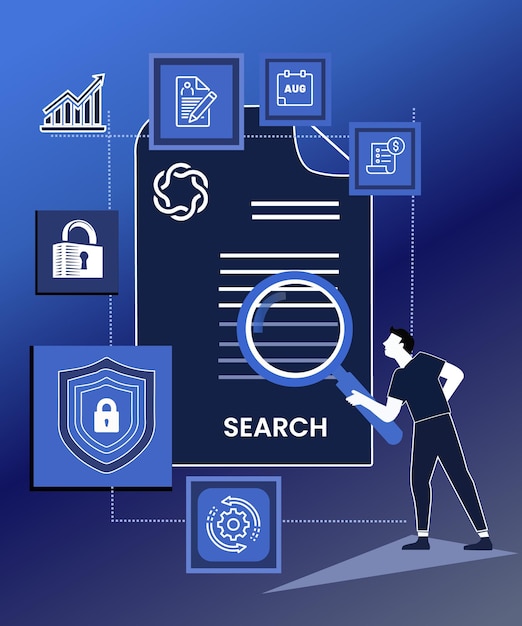Data Privacy in the US: Understanding Regulations and Importance

The growing importance of data privacy in the US is driven by increasing cyber threats and evolving regulations, necessitating robust strategies to protect sensitive information and comply with laws like CCPA and HIPAA.
In today’s digital landscape, the discussion around the growing importance of data privacy: navigating regulations in the US is more critical than ever. As technology advances, so do the challenges in safeguarding personal information. This article explores the driving forces behind this increasing focus, the key regulations in place, and the best practices for organizations to ensure compliance and protect their users.
Understanding the Surge in Data Privacy Concerns
The rise in data privacy concerns is not a sudden phenomenon. It’s a gradual but significant shift driven by several factors. Understanding these drivers is crucial for businesses and individuals alike to appreciate the importance of robust data protection measures.
The Increasing Frequency of Data Breaches
Data breaches are becoming more frequent and sophisticated. These incidents expose sensitive information, leading to financial losses, reputational damage, and legal liabilities. The consequences can be severe for both organizations and individuals.
Growing Awareness Among Consumers
Consumers are becoming more aware of their data rights and the potential misuse of their personal information. This increased awareness is fueled by media coverage of data breaches and scandals, leading to greater demand for transparency and control over how their data is handled.
- Consumers are demanding more control over their personal data.
- There is increased scrutiny of how companies collect and use data.
- Transparency is key to building trust with customers.

The increasing reliance on technology in every aspect of life means that more data is being collected and processed than ever before. This creates a larger attack surface for cybercriminals and increases the potential for data breaches. Furthermore, the interconnected nature of the internet means that a breach in one organization can have ripple effects across the entire ecosystem.
In conclusion, the surge in data privacy concerns highlights the need for companies to take proactive steps to protect personal information, comply with regulations, and foster trust with consumers.
Key Federal and State Data Privacy Regulations
Navigating the legal landscape of data privacy in the US can be complex, with a mix of federal and state laws. Understanding these regulations is crucial for businesses to ensure compliance and avoid penalties.
The California Consumer Privacy Act (CCPA)
The CCPA is a landmark data privacy law in California that grants consumers significant rights over their personal information. It gives consumers the right to know what personal information is collected about them, the right to request deletion of their data, and the right to opt-out of the sale of their personal information.
The Health Insurance Portability and Accountability Act (HIPAA)
HIPAA is a federal law that protects the privacy of individuals’ medical information. It sets standards for the use and disclosure of protected health information (PHI) by healthcare providers, health plans, and other covered entities.
- HIPAA establishes rules for the use and disclosure of PHI.
- It gives patients the right to access and amend their medical records.
- Covered entities must implement safeguards to protect PHI.
Beyond CCPA and HIPAA, several other federal and state laws address specific aspects of data privacy. These include the Children’s Online Privacy Protection Act (COPPA), which protects the online privacy of children under 13, and various state breach notification laws that require organizations to notify individuals when their personal information has been compromised.
In conclusion, understanding and complying with these key data privacy regulations is essential for organizations operating in the US. Failure to do so can result in significant legal and financial consequences.
Building a Robust Data Privacy Framework
Creating a robust data privacy framework is essential for any organization that handles personal information. This framework should encompass policies, procedures, and technologies to protect data throughout its lifecycle.
Conducting a Data Privacy Audit
A data privacy audit involves assessing an organization’s data privacy practices to identify gaps and areas for improvement. This audit should cover all aspects of data handling, from collection and storage to use and disposal.
Implementing Data Encryption and Access Controls
Data encryption and access controls are critical technical safeguards for protecting data. Encryption ensures that data is unreadable to unauthorized users, while access controls limit who can access sensitive information.

Developing clear and concise data privacy policies and procedures is essential for guiding employees and ensuring consistent data protection practices. These policies should outline the organization’s commitment to data privacy, the rights of individuals, and the steps employees must take to protect data.
- Data encryption protects data from unauthorized access.
- Access controls limit who can view and modify sensitive data.
- Regularly review and update security measures to address emerging threats.
In conclusion, building a robust data privacy framework requires a comprehensive approach that includes technical safeguards, policy development, and employee training. By implementing these measures, organizations can better protect personal information, comply with regulations, and build trust with their customers.
The Role of Technology in Enhancing Data Privacy
Technology plays a crucial role in enhancing data privacy. From encryption to privacy-enhancing technologies, there are numerous tools and techniques that organizations can leverage to protect personal information.
Privacy-Enhancing Technologies (PETs)
PETs are technologies that help protect data privacy by minimizing the amount of personal information that needs to be collected and processed. Examples of PETs include differential privacy, homomorphic encryption, and secure multi-party computation.
Data Loss Prevention (DLP) Solutions
DLP solutions help organizations prevent sensitive data from leaving their control. These solutions can monitor data in motion, data at rest, and data in use to detect and prevent unauthorized data transfers.
Cloud computing offers numerous benefits, but it also introduces new data privacy challenges. Organizations must ensure that their cloud providers have adequate security and privacy measures in place to protect their data.
- Privacy-enhancing technologies minimize data collection and processing.
- Data loss prevention solutions prevent unauthorized data transfers.
- Cloud security measures protect data stored in the cloud.
In conclusion, technology is a powerful tool for enhancing data privacy. By leveraging privacy-enhancing technologies, data loss prevention solutions, and cloud security measures, organizations can better protect personal information and comply with regulations.
Data Privacy Best Practices for Businesses
Implementing data privacy best practices is essential for businesses of all sizes. These practices should be integrated into all aspects of the organization, from data collection to disposal.
Obtaining Informed Consent
Obtaining informed consent involves providing individuals with clear and concise information about how their data will be collected, used, and shared. This information should be presented in a way that is easy to understand, and individuals should be given the opportunity to opt-out of data collection.
Implementing Data Minimization
Data minimization involves collecting only the data that is necessary for a specific purpose. By limiting the amount of data collected, organizations can reduce the risk of data breaches and comply with privacy regulations.
Employee training is essential for ensuring that all employees understand their responsibilities in protecting data privacy. Training should cover topics such as data privacy regulations, data security best practices, and the organization’s data privacy policies and procedures.
- Obtain informed consent before collecting data.
- Implement data minimization to collect only necessary data.
- Provide regular employee training on data privacy.
In conclusion, implementing data privacy best practices is essential for protecting personal information and building trust with customers. By obtaining informed consent, implementing data minimization, and providing employee training, organizations can create a culture of data privacy.
The Future of Data Privacy in the US
The future of data privacy in the US is likely to be shaped by several factors, including technological advancements, evolving consumer expectations, and increasing regulatory scrutiny. Staying ahead of these trends is crucial for organizations to maintain compliance and protect personal information.
Increased Focus on Algorithmic Accountability
As artificial intelligence (AI) and machine learning (ML) become more prevalent, there is growing concern about the potential for bias and discrimination in algorithms. This is leading to increased calls for algorithmic accountability, which involves ensuring that algorithms are fair, transparent, and accountable.
The Potential for a Federal Data Privacy Law
Currently, there is no comprehensive federal data privacy law in the US. However, there is growing support for such a law, which would provide a consistent set of data privacy rights and obligations across the country.
Data ethics is becoming increasingly important as organizations collect and use more data. Data ethics involves considering the ethical implications of data collection and use and ensuring that data is used in a responsible and ethical manner.
- Increased focus on algorithmic accountability.
- Potential for a federal data privacy law.
- Growing importance of data ethics.
In conclusion, the future of data privacy in the US is likely to be shaped by technological advancements, evolving consumer expectations, and increasing regulatory scrutiny. By staying ahead of these trends and embracing data ethics, organizations can better protect personal information and build trust with their stakeholders.
| Key Aspect | Brief Description |
|---|---|
| 🛡️ Data Privacy | Safeguarding personal information against unauthorized access. |
| ⚖️ Regulations | Complying with CCPA, HIPAA, and other privacy laws. |
| 🔒 Security | Implementing encryption and access controls. |
| 📊 Awareness | Educating consumers and employees about data rights. |
Frequently Asked Questions (FAQ)
▼
The California Consumer Privacy Act (CCPA) is a state law that enhances privacy rights and consumer protection for California residents. It grants specific rights regarding their personal information.
▼
HIPAA sets standards for using and disclosing protected health information (PHI), ensuring confidentiality. Patients have rights to access and amend details, with covered entities implementing security.
▼
Data encryption is critical for protecting sensitive data from unauthorized access, especially during transmission and storage. Data encryption keeps data secure by converting it into an unreadable format.
▼
Data minimization is collecting only the data needed for a specific purpose, reducing the risk of breaches and complying with privacy. It minimizes the potential harm of data compromises.
▼
Businesses can start with data privacy audits, data encryption, and clear policies that train employees. This establishes a comprehensive data privacy culture within the organization.
Conclusion
As we navigate an increasingly digital world, the growing importance of data privacy and the necessity of understanding and complying with US regulations cannot be overstated. By implementing robust data privacy frameworks, staying informed about technological advancements, and prioritizing data ethics, organizations can safeguard personal information and build trust with their customers and stakeholders.





